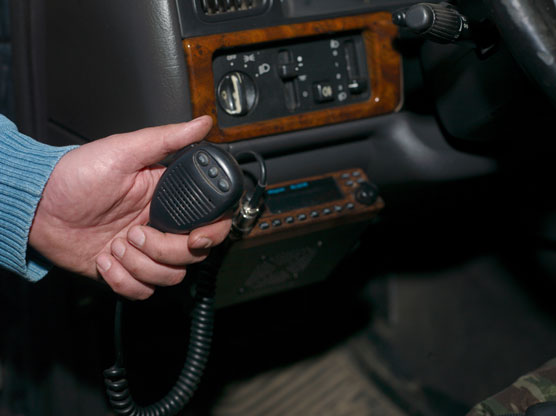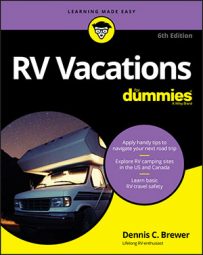Smartphone
As an RV traveler, you probably need to give up your flip phone. Smartphones and the apps that run on them can do just about anything but the laundry. You can use them to check Facebook, tweet, and pin; surf the web; text, message, or email; and play sweet games. And don’t forget that they can make calls to other cell and landline phones from just about anywhere.Some aspects of smartphones make them indispensable for RVers. They have navigation apps and phone service, and they can be used as Wi-Fi hotspots to connect other devices to the Internet.
- Navigation apps. All smartphones offer some form of navigation capability, often built into the phone’s standard software and accessible by voice command or from within the web browser. Get accustomed to using these navigation apps by taking car trips to places you know and have gone to before, such as the grocery store or the mall, and listen to and follow the turn by turn directions to get there. This way, you will be familiar with how the apps work when you need them to lead the way.
There generally are settings in the apps to rule out road types, like secondary, and having to use a ferry boat to get there. Learn all the settings you can adjust so that you can tune the device to work its best for you.
Study a paper map and know where you are going before you depart in your RV. Smartphone GPS navigation apps are generally programmed to direct a car, pickup truck, or SUV, or perhaps a semi-truck, not a motor home that needs 12 feet, 7 inches of overhead clearance or weighs in over 28,000 pounds. They also have a tendency to take you along the shortcut, not the big truck route by-pass you really need to use, so some knowledge of your desired routing is necessary so you know when to not “turn right here” as the app directs.
- It’s a phone, too. No more hunting for the phone booth needed across 90 percent of the places you will travel in the U.S. and Canada. All the major carriers publish a map showing where they think they have coverage for voice and data.
When you shop for a smartphone, consider one with a large screen. Find a case or holder that keeps the phone firmly fixed near the driver’s or navigator’s seat. Also, find a handsfree Bluetooth earpiece or headset that lets you communicate with the phone if your motor home’s radio isn’t Bluetooth-capable.
Practice using the phone and its features when someone else is driving. If you’re going to do the driving, set the navigation app before you start out. If the app fails, find a safe place to pull over and reset your routing on the application.NOAA weather radio
The National Oceanic and Atmospheric Administration (NOAA) weather-radio channels may not cover all the areas you travel across or stay in, but having a NOAA radio is still essential for those times when it does. In most areas, a NOAA weather radio can keep you informed so that you can keep yourself and your family safe when the weather doesn’t cooperate with your plans. A NOAA weather radio tunes to all seven VHF frequencies from 162.400 MHz to 162.550 MHz.Here are where you can find NOAA coverage maps for the US and Canada:
Having a smartphone, radio, TV set, and weather radio on board increases your chances of staying connected to weather information and warnings, which can help you make safe travel decisions.
Dedicated hotspot device
A dedicated hotspot device can maintain an Internet connection for the kids or travel companions without interfering with what is happening on your smartphone. Most all of the major carriers sell a dedicated hotspot device that you can keep in the motor home to provide Internet connectivity for all those other devices you need these days. Adding one of these devices to your cell phone plan will cost a bit more, but it can be well worth it to carry the convenience of Internet access with you on the road. It also provides the option to keep something in the RV connected to the Internet when you are on an errand or daytrip somewhere with the tow car or truck. You can also use the hotspot WI-FI device to connect some GPS models to the Internet for live weather and traffic information.Consider buying one of the newer superfast 5G capable hotspot device. Soon the nation will be covered with 5G capable towers giving superfast data speeds to meet your on-the-road connectivity needs. Also consider buying one that can connect to an external antenna. This will give you a more stable connection and increase the distance from which you can stay connected to a cell phone tower.
RV-specific GPS device
This indispensable gadget helps you maintain turn-by-turn awareness, safety, and convenience while driving your RV. One big benefit of having a Global Positioning System (GPS) device specifically designed for RV use is that it can take into consideration your vehicle’s characteristics, such as overhead clearance; it won’t take you down a road with 10-foot overhead clearance when you need 12 feet, 8 inches.Another great advantage of a GPS designed for RV use is lane-awareness and lane-change advice, which is particularly useful in large cities; many major highways and interstates require prompt lane changes.
RV-specific GPS devices are available in two different styles: a dedicated GPS function or a tablet with a GPS feature that will also do other things. Some models include bells and whistles such as a dashboard camera and trip recorder. As with any tech gadget, learn to use it before you need it. Consider favoring a larger viewing screen when you decide which model to buy.
Make sure that the device is in RV mode for height clearance and weight when you’re pulling your fifth-wheel or driving your Class A or class B motor home down the highways and byways of North America.
Some of the most useful features to look for include RV routing based on size and weight, phone connectivity for traffic updates, preloaded points of interest, voice-enabled command features, and preloaded information on campgrounds.
Digital tire-pressure gauge
A small digital tire-pressure gauge is an indispensable tool for checking the tires of your RV, trailer, fifth-wheel, or tow car on a frequent basis. Knowing the recommended tire pressures for all vehicles and trailers and checking them frequently enables you to catch tire problems before they become big problems. It is good practice to always check your tire pressures first thing in the morning before leaving on the trip or your days travels.Having one tire out of four or six running a pressure 10 percent or more below the other tires is a clue that it’s time to get some service on that tire when you’re near a service facility. If all tires’ pressures are low by an equal amount after a big swing in outdoor temperatures, you may just have to add a little more air before getting on the road again. Your trailer, RV, or towed car performs best when all the tires are at recommended pressure.
A handy digital pressure gauge helps you keep tires in spec, improves gas mileage, and reduces uneven wear, extending the life of the tires while contributing to on-the-road safety.
Multimeter
This little electronic test meter helps you make sure that your RV’s house or coach batteries are charging properly (13.8 to 14.7 volts DC) regardless of the source of charging current. The on the engine alternator, on-board generator, or the AC to DC converter when connected to campground AC power should all produce a charging current in that voltage range. You can also use this meter to check for adequate AC voltage in an outlet or camp power pedestal. A multimeter can also identify whether a house or clearance light bulb is burned out and whether a fuse is blown.Learning how to use this testing tool and how your RV’s electrical system operates can save you many service bills and trips to the dealership, and help keep your rig, lights, and devices properly powered.
Rechargeable battery-powered vacuum cleaner
Some big rigs and even class Cs have built-in vacuum cleaners. For the rest, you benefit from having a battery-powered handheld or standard-size rechargeable vacuum cleaner on board. From cleaning up beach sand to desert dust and pet hair to getting rid of angry unwelcome insects, a portable vacuum cleaner helps keep the RV clean and tidy. You can also use it to clean the carpets in the tow car or the pickup truck that pulls the trailer.Charge the vacuum’s battery every time you’re hooked up to a campground power pedestal, and keep all the attachments in one place, such as a bag or toolbox.
CB radio
Most folks consider a citizens’ band (CB) radio to be “old-school,” and it is. But old-school isn’t no school. This radio can still be helpful; many over-the-road truckers and RVers have a CB turned on, monitoring channel 19 to hear what’s happening up ahead as they roll down the road. Some police agencies monitor channel 9 (the help channel), so you can shout out to them if necessary. ©victoras/Shutterstock.com
©victoras/Shutterstock.comConsider buying a pair of handheld CB portable units so that you can use them in and around the campsite to call the kids in for dinner or s’mores around the campfire.
Small oil-filled electric heater
Even though your RV is likely to be equipped with a propane furnace, heat pump, or resistance-heat-assisted air conditioner that can provide heat on cold nights, this gadget can help. You can use a small radiator like liquid filled electric heater to warm up the sleeping area or take the chill out of a bathroom. This type of heater is a low-cost alternative to draining the propane tank; also, it’s quiet, giving light sleepers a bit of heat without the noise of the built-in heating alternatives.When you need a little bit of heat in a small space without going over a 20- or 30-amp hookup limit, a small heater can fill the bill on chilly but not-quite-freezing nights.
Emergency signs and lights
RVers hope that they’ll never have tire failures or mechanical breakdowns. If misfortune should strike, though, it’s helpful to warn other travelers that your vehicle is disabled on the side of the road. Most states have move-over laws that require motorists to slow down or move over a lane away from stalled or disabled vehicles. Triangular warning signs and emergency warning lights placed behind your vehicle warn other motorists of your plight and keep you safe.States that have move-over laws are listed online. As a courteous RV driver, however, you should always get over if you can safely do so.
Some RVers carry railroad flares for night warnings, and using them is okay, but you should consider the flames and the risk to users. LED light kits are a safe alternative.

